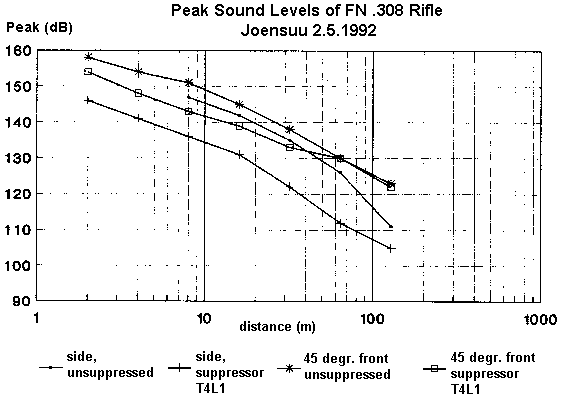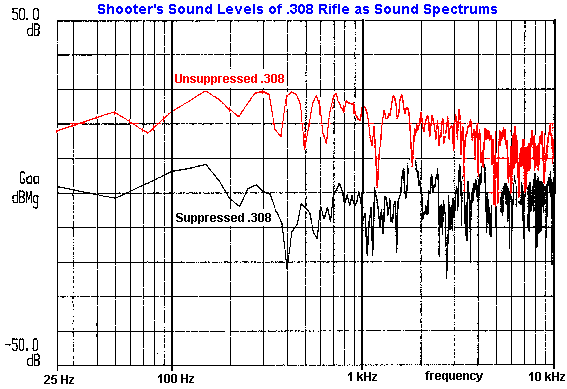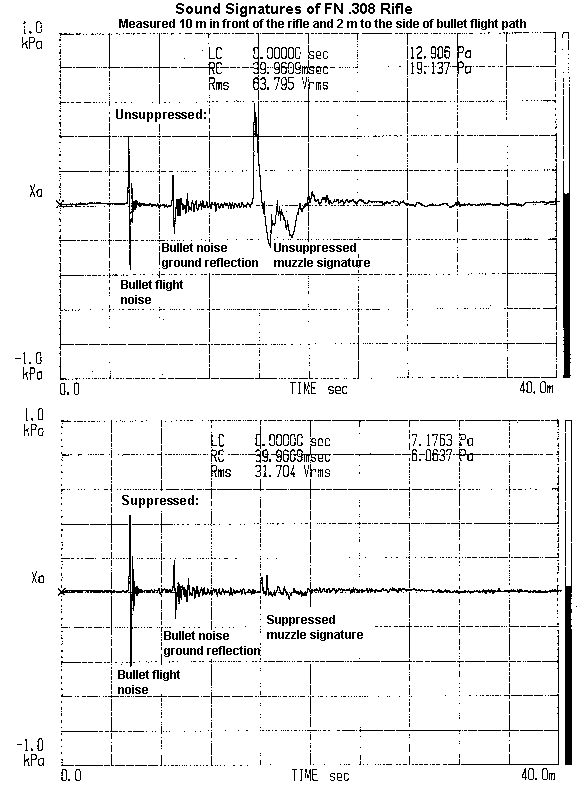
.308 Measured

The sound levels above were measured from 2 to 128 meters distance in Joensuu by Dr. Rauno Pääkkönen and Chief Engineer Ilkka Kyttälä of Finish Ministy of Labour with a FN FAL L1A1 rifle using .308 Win standard high velocity ammo (initial velocity abt. 700 m/s). Sound levels were measured as unsuppressed and suppressed with a short T4L1 Ranger Reflex Suppressor from right angle and from 45 degrees angle in front of the rifle. As expected, suppressed and unsuppressed levels in front of the rifle were rather close to each other because of the flight noise of supersonic bullet. To the side the sound levels were significantly reduced. A new finding was that a suppressor reduces sound level more efficiently near the firearm than farther away. This is declared by the nature of high frequencies tending to get dampened earlier when traveling in air than low frequencies. High frequencies are also easier to attenuate by a suppressor than the bassy part of the gunshot which travels farther.

What frequencies do dominate the gunshot, then? This sound spectrum measured by Dr. Rauno Pääkkönen during Finnish Suppressor Project with a FN FAL .308 rifle both as unsuppressed (red line) and equipped with a T8L1 Scout Reflex Suppressor (black line) tells that shooter's sound level maximums are typically from 130 Hz to 3 kHz frequency range. A suppressor decreases the most harmful sound levels of the spectrum effectively. Gunshots typically create hearing loss within this range causing typically difficulties to understand speech or ringing in the ears. These damages can not be cured. Hearing protection can not be used in all situations like while hunting. Suppressors offer effective means to fight against permanent hearing damages. Best way to guard your hearing is to use a suppressor together with conventional means of hearing protection, whenever possible.

Above pictures shows typical unsuppressed and suppressed sound signatures with bullet noises as measured 10 meters in front of the rifle and 2 meters to the side of bypassing supersonic .308 bullet fired from a FN FAL rifle. The unsuppressed muzzle signature in the upper image is even louder than the bullet sonic crack preceding it. For human ears these two sounds come so close together they resemble one discharge. The curve in the image below shows the almost vanished suppressed muzzle signature. However, listened by ear the remaining bullet sound seems almost as loud as the suppressed shot. This is why a suppressor has practically no effect on sound levels in front of a rifle. Behind the rifle at shooter's position the bullet noise is almost nonexistent and 20 dB of the muzzle noise stressing his ears can be reduced. The suppressor can be used for efficient hearing protection of the shooter, but not for hiding the fact from that a high power rifle has been fired! For specific info see a page about bullet flight sound.
Rauno Pääkkönen (left) and Ilkka Kyttälä walking back from a succesfull distance attenuation in Lähdekorpi shooting range 2.5.1999. Gunwriter P. T. Kekkonen served as a test shooter of the FAL rifle equipped with a T8L1 Scout Reflex Suppressor.
Picture above: Noise levels of
five .308 suppressors compared to unsuppressed noise levels of a Tikka M595 rifle with
bare muzzle and a Sako TRG21 equipped with a muzzle brake. Lowest shooter's noise levels
(blue) were provided by both Ase Utra and the BR-Tuote T8 Scout suppressors, which produced levels clearly below the
hearing damage limit of 140 dB. Porras almost reached the limit. Although Sako exceeded
the risk limit by eight decibels it's 10 meter side noise level (black) was among the
three lowest along with the T8 Scout and Ase Utra 2.
As shooter's noise level tells the level of hearing protection os a suppressor, the 10
meters to the side level is used to estimate the average environmental noise pollution of
a firearm. 1 m side noise level (yellow) is used for some military purposes, but it can
also be used for estimating the noise exposure of a hunting dog accidentally got too close
to the muzzle while a hunting rifle is fired. The 1 m level was lowest with the T8 Scout,
followed closely by Sako and both Ase Utra models.
Unsuppressed levels (the two groups on the right) exceeded the 140 dB hearing damage risk
level even at 10 meters side position (black) and reached 158 dB at shooter's position.
When shot with an effective muzzle brake, a .308 rifle produced still 9 decibels higher
noise to the shooter - a level of 167 dB can cause damage even with single shots to
unprotected hearing! The muzzle brake did not have equal effect on the side noise levels
(yellow and black). Source: Suppressor Trials May 28, 1999.
Measured by Dr. Rauno Pääkkönen.
Picture above: Is there any
correlation between suppressors attenuations (net sound reductions) measured from three
positions: beside shooters ear, 1 meter to the side and 10 meters to the side of the
muzzle? 1 meter to the side of the muzzle seems to systematically give higher attenuation
measures than the 10 meter environmental noise measuring position. This is probably due to
that high frequencies dominating firearm muzzle report are damped quicker while traveling
through the air than the low frequencies. However, both 1 m and 10 m side attenuations
correlate positively: If either side attenuation is high, the other is usually also high.
When measured beside beside shooter's ear (hearing protection position) the correlation to
both side position seems to be negative with most measured suppressors. Those suppressors
having exceptionally good shooter's attenuation may produce low or average side
attenuations and good side attenuator suppressors may be average or insufficient for
shooter's hearing protection. Declaration to this is: Although a correctly designed
suppressor is able to absorb sound energy relatively to it's size, the remaining sound
escaping the suppressor can be directed to different directions depending on suppressor
design. If designed and optimized for good shooter's noise attenuation the remaining
escaping sound energy is usually directed to other directions like to the side. This acts
also vice versa: Trimming a suppressor for good side attenuation may result to more sound
directed towards the shooter. Source: Suppressor Trials May
28, 1999. Measured by Dr. Rauno Pääkkönen.
308 Rifle Measuring Data on Internet: http://guns.connect.fi/rs/308measured.html
Index Main General Rifles 50 BMG SMG MG Contact Links Measuring License Manufacturing Lyddemper.net Suppressors in the UK